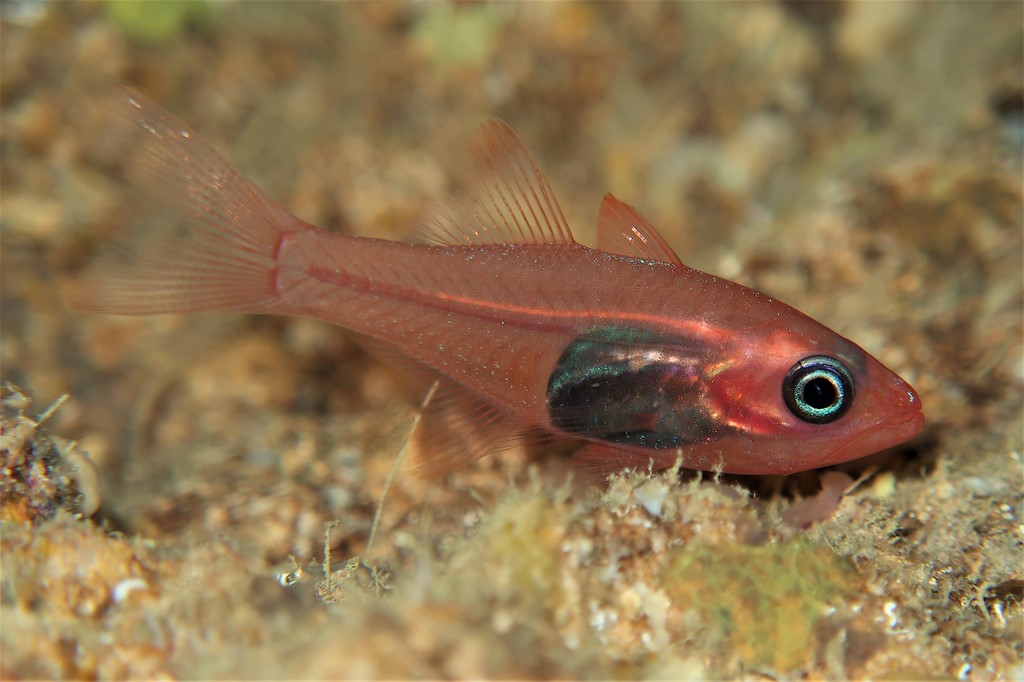LACHNERATUS PHASMATICUS - (FRASER & STRUHSAKER, 1991)
Picture courtesy of: Alain Daoulas
Poisson cardinal fantôme, Phantom Cardinalfish,
Similar species
Cercamia cladara (Randall & Smith, 1988) - Reported from New Caledonia - Link to the species (here).
Cercamia melanogaster (Allen, Erdmann & Mahardini, 2015) - Reported from Western Pacific: West Papua (Indonesia).
Description
Dorsal spines (total): 6; Dorsal soft rays (total): 1 spine + 12-13 rays; Anal spines: 2; Anal soft rays: 14-16. Pectoral fin rays: 10; Pelvic fin rays: I, 5; Principal caudal fin rays: 9 + 8; Secondary caudal fin rays bilateral and segmented; Total gill rakers and rudiments: 17-19, well-developed gill rakers: 16-17, upper arch with one rudiment and two gill rakers, lower arch: 0-1 rudiments and 14-15 gill rakers. Body depth: 25.5-31.6 (usually: 28.4); Head length: 34.6-42.7 (usually: 40.9); Eye length: 8.4-10.8 (usually: 8.7); Snout length: 8.5-11.1 (usually: 10.7). Vertebrae: 10+14, pleural ribs on third through tenth centra, epiplural ribs on first through third vertebrae; Predorsals absent. Scales cycloid, very deciduous, no complete counts available; No scales with pores or pits to indicate the presence of a lateral line. Villiform and caninoid teeth on dentary in one to two rows; Wide band of villiform teeth at sides of premaxilla with one or two rows of caninoid teeth near symphysis; One or two canine teeth on vomer; One to two rows of villiform teeth on palatine; No teeth on ectopterygoid, endopterygoid or basihyal. Max. length: 7.4 cm SL. Depth range: 3 - 104 m.
Dorsal spines (total): 6; Dorsal soft rays (total): 1 spine + 12-13 rays; Anal spines: 2; Anal soft rays: 14-16. Pectoral fin rays: 10; Pelvic fin rays: I, 5; Principal caudal fin rays: 9 + 8; Secondary caudal fin rays bilateral and segmented; Total gill rakers and rudiments: 17-19, well-developed gill rakers: 16-17, upper arch with one rudiment and two gill rakers, lower arch: 0-1 rudiments and 14-15 gill rakers. Body depth: 25.5-31.6 (usually: 28.4); Head length: 34.6-42.7 (usually: 40.9); Eye length: 8.4-10.8 (usually: 8.7); Snout length: 8.5-11.1 (usually: 10.7). Vertebrae: 10+14, pleural ribs on third through tenth centra, epiplural ribs on first through third vertebrae; Predorsals absent. Scales cycloid, very deciduous, no complete counts available; No scales with pores or pits to indicate the presence of a lateral line. Villiform and caninoid teeth on dentary in one to two rows; Wide band of villiform teeth at sides of premaxilla with one or two rows of caninoid teeth near symphysis; One or two canine teeth on vomer; One to two rows of villiform teeth on palatine; No teeth on ectopterygoid, endopterygoid or basihyal. Max. length: 7.4 cm SL. Depth range: 3 - 104 m.
Color
Translucent red body; Reddish first dorsal and pelvic fins; Intestine black, peritoneum silvery to gray and black.
Etymology
Lachneratus: named for Ernest A. Lachner, Curator Emeritus of the United States National Museum of Natural History, Washington, D.C., in recognition of his contributions to the systematics of Indo-West Pacific cardinalfishes + from Latin suffix, -atus = indicating the possession of a thing or a quality.
phasmaticus: from Greek phasma, -atos = phantom + from Latin suffix, -icus = belonging to, derived from. Referring to its “elusive phantomlike nature” (known from single specimens collected in 1964 and 1974, its identity proved elusive until more specimens were located in 1982 and 1983).
Original description: Lachneratus phasmaticus Fraser & Struhsaker, 1991 - Type locality: Hawaiian Islands, Hawaii Island, Kona coast at cave on north side of Ka'u Loa Point, about 20-30 m back from entrance in 3-5 m of water, J. E. Randall and B. A. Carlson collectors, 23 July 1983, color transparency in Randall collection.
Distribution
Indo-West Pacific: Comoros, Mascarenes (Mauritius); New Caledonia, Vanuatu, Fiji, Marquesas Islands; Hawaiian Islands (U.S.A.).
Translucent red body; Reddish first dorsal and pelvic fins; Intestine black, peritoneum silvery to gray and black.
Etymology
Lachneratus: named for Ernest A. Lachner, Curator Emeritus of the United States National Museum of Natural History, Washington, D.C., in recognition of his contributions to the systematics of Indo-West Pacific cardinalfishes + from Latin suffix, -atus = indicating the possession of a thing or a quality.
phasmaticus: from Greek phasma, -atos = phantom + from Latin suffix, -icus = belonging to, derived from. Referring to its “elusive phantomlike nature” (known from single specimens collected in 1964 and 1974, its identity proved elusive until more specimens were located in 1982 and 1983).
Original description: Lachneratus phasmaticus Fraser & Struhsaker, 1991 - Type locality: Hawaiian Islands, Hawaii Island, Kona coast at cave on north side of Ka'u Loa Point, about 20-30 m back from entrance in 3-5 m of water, J. E. Randall and B. A. Carlson collectors, 23 July 1983, color transparency in Randall collection.
Distribution
Indo-West Pacific: Comoros, Mascarenes (Mauritius); New Caledonia, Vanuatu, Fiji, Marquesas Islands; Hawaiian Islands (U.S.A.).
Biology
A nocturnal species inhabiting caves and crevices during the day.
A nocturnal species inhabiting caves and crevices during the day.
Similar species
Cercamia cladara (Randall & Smith, 1988) - Reported from New Caledonia - Link to the species (here).
Cercamia melanogaster (Allen, Erdmann & Mahardini, 2015) - Reported from Western Pacific: West Papua (Indonesia).
Last update: 20, July 2024
